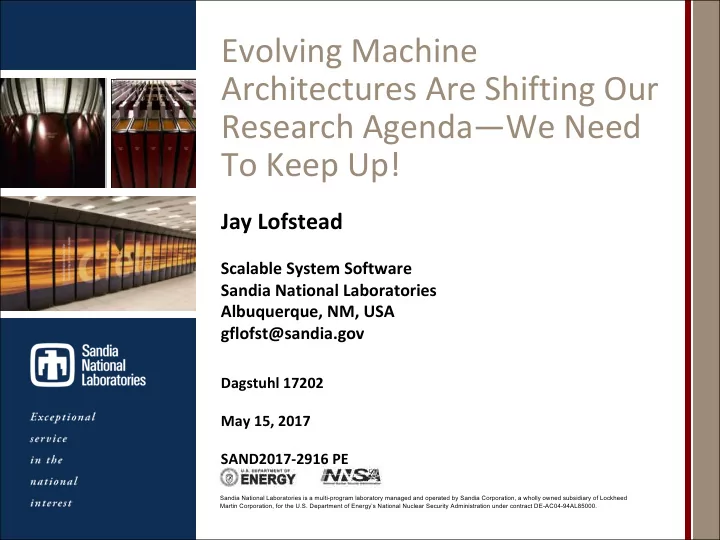

Evolving Machine Architectures Are Shifting Our Research Agenda—We Need To Keep Up! Jay Lofstead Scalable System Software Sandia National Laboratories Albuquerque, NM, USA gflofst@sandia.gov Dagstuhl 17202 May 15, 2017 SAND2017-2916 PE Sandia National Laboratories is a multi-program laboratory managed and operated by Sandia Corporation, a wholly owned subsidiary of Lockheed Martin Corporation, for the U.S. Department of Energy’s National Nuclear Security Administration under contract DE-AC04-94AL85000.
Overview § New memory and storage technologies are inserting new layers into memory/storage hierarchy § The dividing line between memory and storage, already blurry, is being obliterated § The architectural evolution is underway, but we are a fair distance from what we can see is coming still § We have not solved adequately the problems inherent in the architectures being deployed today, not to mention those of the future (e.g., burst buffer support and integration problematic still) § Networking is becoming part of the memory hierarchy instead of just the storage hierarchy 2
File/Storage Systems Questions § If POSIX interface is gone, are there files? § How do we identify a collection of bytes we want? § If we use CPU-level get/put instead of block read/write is it storage still? § Either directly or via something like libpmem or mmap § Do we need a storage abstraction for portability anymore? § Endian-ness is almost exclusively little endian now. § Are there other motivations? § Are consistency and coherence a programmer or file/storage system responsibility? What about security? § Since networking people worry about machine instructions, what can storage/IO people afford as service functionality? 3
Phase 1 Architecture § Use extra compute nodes for their memory § Data staging work starting in the 1990s, picked up steam in the 2000s. § Chain of evidence suggests this is the origin of “burst buffers”, as least in name 4
Predominant Uses (Phase 1) § Manually managed IO bursts § IO Forwarding nodes on BlueGene § Offloading communication-heavy operations to fewer nodes with more data each § FFT for seismic data § Offloading independent operation to fewer nodes for asynchronous processing § Calculating min/max, bounding box filtering, etc. 5
Phase 2 Architecture (and Software) =0*(,#'% 3*+450'% !&3%@,I(".% 89:%6*7'2% =E6%@,I(".% ='(1'(2% 6*7'2% >&8%9%&*(0,B2% ;5(20%;5<'(% :@J/% Application 89:%@*(A,(7"-#%='(1'(% Lustre Server >&8?8:% I/O Dispatcher !/@F% C:G% &:=8H% Lustre Client 6CDE>% (DAOS+POSIX) 89:%@*(A,(7"-#%3B"'-0% 6
Predominant Uses (Phase 2) § Offer Flash into or near IO path § Some job scheduler support, including rudimentary allocation, data pre-staging, and data draining § Suggest use for data rearrangement (fast array dimension) and similar processing § Not completely though through since these are IOPS bound activities that effectively remove devices from availability slowing aggregate IO bandwidth for the machine. § If only IO path to storage is through these devices, potential problems abound 7
Phase 2a Architecture § Same as Phase 2, except the NVM is on the compute nodes instead of centralized. § Additional examples, such as Aurora at ANL, will have both models. § When on compute node only, interference effects can be significant (network, device, potentially memory or disk bus affecting local node use) § Summit will be a test case for Phase 2a § SCR attempting to leverage these architecture for checkpoints 8
Phase 3 Architecture § Nodes gain HBM on package and more memory/storage in the memory bus or PCIe Node Architecture HBM DRAM/ Mem Bus CPU Flash Package § Additional node-local storage added § 3D XPoint most hyped example § node-local Flash/SSDs also possible due to form factor 9
Phases 2 & 3 Challenges § Storage devices reach or exceed interconnect speeds § Storage stack overheads no longer hidden by device latencies § Unlike DRAM and disk, NVM has an erase cycle that takes as long as writing. We need to program understanding that overwriting costs 2x writing to clean space. § Some belief background erasure can address this (not me). § Maintaining coherency and consistency for multi-user, globally shared space 10
Predominant Use Cases (Phase 3) § Out of core computations § Better support for data analytics workloads as a side benefit § RDMA access still probably desired, but less interference since memory bus will only be hit when leaving the CPU package § Do we buy any memory/storage for local memory bus since spending so much for HBM? 11
Phase 4 Architecture § Memory-centric Design (Gen-Z Consortium) § HPE “The Machine” prototype § In network (on switches) storage § DRAM, potentially in the same address space § Line between memory and storage all but gone 12
Predominant Use Cases (Phase 4) § Coherent virtual fat nodes operating on 10s TB § Persistent storage near/fast enough to “swap” to § Online workflows become the natural model § Lots of places to stash data between compute components § Easier programming model to access data since it can be in a shared, directly addressable address space (just pass a pointer). 13
What is Memory or Storage? § Things placed in memory have external metadata, generally in program code § more compact representation, optimized for interaction with the processors § Things placed in storage are wrapped in metadata to make them easily usable by other applications § file formats to make reading simulation output into visualization tool § prescribed (or annotated) endianness. § What about shared fate? What about wrapping metadata around data in DRAM? 14
Sirius Project Contributions § DOE ASCR SSIO Project at mid-point § User level deciding how to split data sets into higher information density chunks § ZFP, split doubles at the byte level, striding, combinations, or others § Data placement management tools § writing EVERYWHERE (really objects in essence even though files now) § restage months later for reading based on information density (utility) § Metadata management for querying based on data contents § and support QoS needs § Quality of Service at the storage device level to give reasonable predictions for IO operations § reservations, ML-based prediction, and historical timing statistics 15
Questions? Jay Lofstead gflofst@sandia.gov 16
Recommend
More recommend